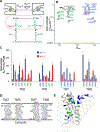Key residues controlling bidirectional ion movements in Na+/Ca2+ exchanger
- PMID: 30248574
- PMCID: PMC6688843
- DOI: 10.1016/j.ceca.2018.09.004
Key residues controlling bidirectional ion movements in Na+/Ca2+ exchanger
Abstract
Prokaryotic and eukaryotic Na+/Ca2+ exchangers (NCX) control Ca2+ homeostasis. NCX orthologs exhibit up to 104-fold differences in their turnover rates (kcat), whereas the ratios between the cytosolic (cyt) and extracellular (ext) Km values (Kint = KmCyt/KmExt) are highly asymmetric and alike (Kint ≤ 0.1) among NCXs. The structural determinants controlling a huge divergence in kcat at comparable Kint remain unclear, although 11 (out of 12) ion-coordinating residues are highly conserved among NCXs. The crystal structure of the archaeal NCX (NCX_Mj) was explored for testing the mutational effects of pore-allied and loop residues on kcat and Kint. Among 55 tested residues, 26 mutations affect either kcat or Kint, where two major groups can be distinguished. The first group of mutations (14 residues) affect kcat rather than Kint. The majority of these residues (10 out of 14) are located within the extracellular vestibule near the pore center. The second group of mutations (12 residues) affect Kint rather than kcat, whereas the majority of residues (9 out 12) are randomly dispersed within the extracellular vestibule. In conjunction with computational modeling-simulations and hydrogen-deuterium exchange mass-spectrometry (HDX-MS), the present mutational analysis highlights structural elements that differentially govern the intrinsic asymmetry and transport rates. The key residues, located at specific segments, can affect the characteristic features of local backbone dynamics and thus, the conformational flexibility of ion-transporting helices contributing to critical conformational transitions. The underlying mechanisms might have a physiological relevance for matching the response modes of NCX variants to cell-specific Ca2+ and Na+ signaling.
Copyright © 2018 Elsevier Ltd. All rights reserved.
Conflict of interest statement
Conflict of interest
All authors state no conflict of interests.
Figures









Similar articles
-
Structure-Based Function and Regulation of NCX Variants: Updates and Challenges.Int J Mol Sci. 2022 Dec 21;24(1):61. doi: 10.3390/ijms24010061. Int J Mol Sci. 2022. PMID: 36613523 Free PMC article. Review.
-
Functional asymmetry of bidirectional Ca2+-movements in an archaeal sodium-calcium exchanger (NCX_Mj).Cell Calcium. 2014 Oct;56(4):276-84. doi: 10.1016/j.ceca.2014.08.010. Epub 2014 Aug 27. Cell Calcium. 2014. PMID: 25218934
-
Structure-dynamic and functional relationships in a Li+-transporting sodium‑calcium exchanger mutant.Biochim Biophys Acta Bioenerg. 2019 Mar 1;1860(3):189-200. doi: 10.1016/j.bbabio.2018.11.015. Epub 2018 Nov 8. Biochim Biophys Acta Bioenerg. 2019. PMID: 30414928
-
Asymmetric Preorganization of Inverted Pair Residues in the Sodium-Calcium Exchanger.Sci Rep. 2016 Feb 15;6:20753. doi: 10.1038/srep20753. Sci Rep. 2016. PMID: 26876271 Free PMC article.
-
Structure-Functional Basis of Ion Transport in Sodium-Calcium Exchanger (NCX) Proteins.Int J Mol Sci. 2016 Nov 22;17(11):1949. doi: 10.3390/ijms17111949. Int J Mol Sci. 2016. PMID: 27879668 Free PMC article. Review.
Cited by
-
Structural dynamics of Na+ and Ca2+ interactions with full-size mammalian NCX.Commun Biol. 2024 Apr 16;7(1):463. doi: 10.1038/s42003-024-06159-9. Commun Biol. 2024. PMID: 38627576 Free PMC article.
-
Exploring the Li+ transporting mutant of NCX_Mj for assigning ion binding sites of mitochondrial NCLX.Cell Calcium. 2022 Nov;107:102651. doi: 10.1016/j.ceca.2022.102651. Epub 2022 Sep 9. Cell Calcium. 2022. PMID: 36116246 Free PMC article.
-
New understanding of electrical activity brought by surface potential of cardiomyocytes.Sci Rep. 2021 Mar 23;11(1):6593. doi: 10.1038/s41598-021-86138-w. Sci Rep. 2021. PMID: 33758297 Free PMC article.
-
Structure-Based Function and Regulation of NCX Variants: Updates and Challenges.Int J Mol Sci. 2022 Dec 21;24(1):61. doi: 10.3390/ijms24010061. Int J Mol Sci. 2022. PMID: 36613523 Free PMC article. Review.
-
The Archaeal Na+/Ca2+ Exchanger (NCX_Mj) as a Model of Ion Transport for the Superfamily of Ca2+/CA Antiporters.Front Chem. 2021 Jul 30;9:722336. doi: 10.3389/fchem.2021.722336. eCollection 2021. Front Chem. 2021. PMID: 34409017 Free PMC article. Review.
References
-
- Philipson KD, Nicoll DA, Sodium-calcium exchange: a molecular perspective, Annu. Rev. Physiol. 62 (2000) 111–133. - PubMed
-
- Blaustein MP, Lederer WJ, Sodium/calcium exchange: its physiological implications, Physiol. Rev. 79 (1999) 763–854. - PubMed
-
- Khananshvili D, The SLC8 gene family of sodium-calcium exchangers (NCX): structure, function, and regulation in health and disease, Mol. Asp. Med. 34 (2013) 220–235. - PubMed
-
- Palty R, Silverman WF, Hershfinkel M, Caporale T, Sensi SL, Parnis J, Nolte C, Fishman D, Shoshan-Barmatz V, Herrmann S, Khananshvili D, Sekler I, NCLX is an essential component of mitochondrial Na+/Ca2+ exchange, Proc. Natl. Acad. Sci. U. S. A. 107 (2010) 436–441, 10.1073/pnas.0908099107. - DOI - PMC - PubMed
-
- Khananshvili D, Sodium-calcium exchangers (NCX): molecular hallmarks underlying the tissue-specific and systemic functions, Plügers Arch. 466 (2014) 43–60. - PubMed
Publication types
MeSH terms
Substances
Grants and funding
LinkOut - more resources
Full Text Sources
Other Literature Sources
Miscellaneous

